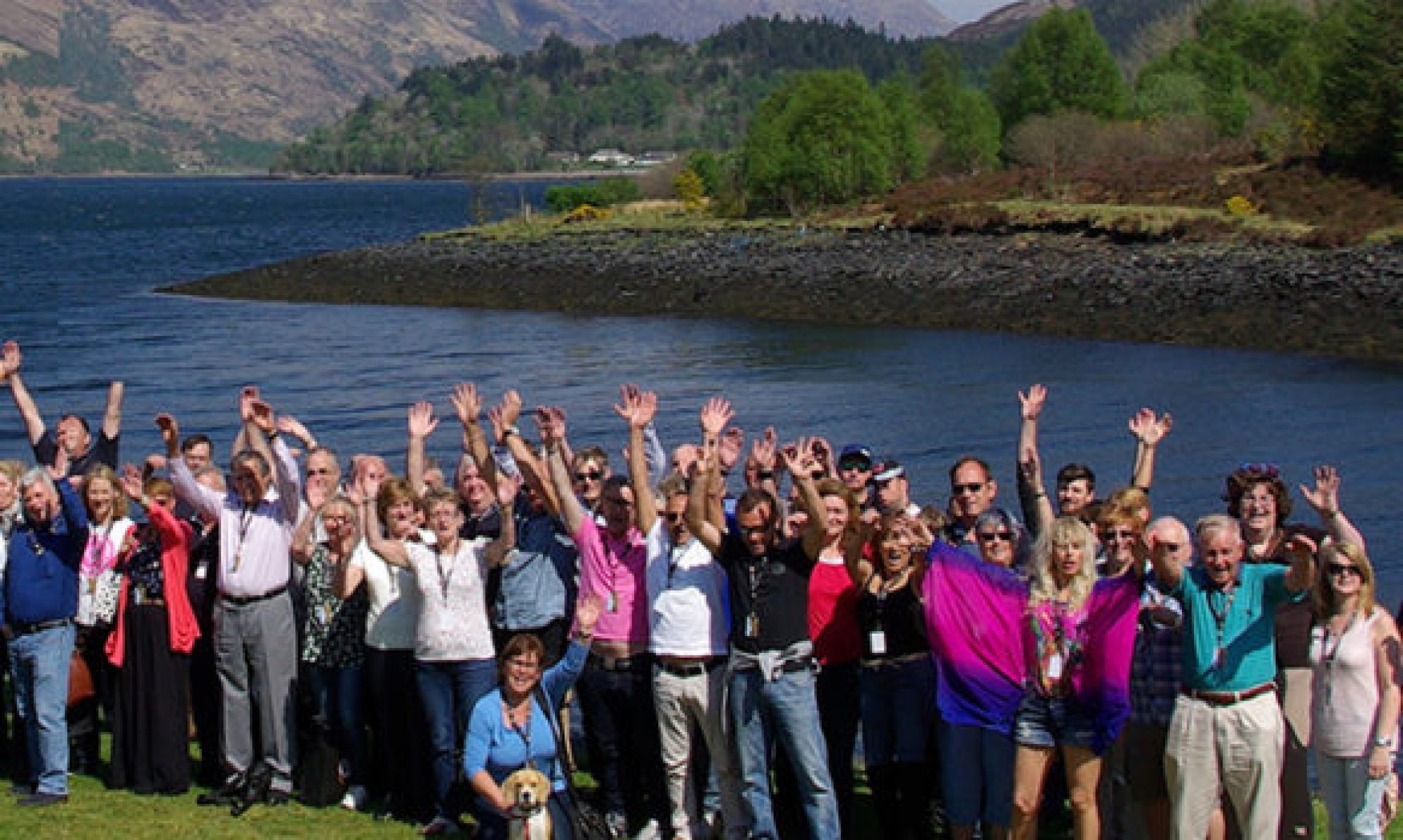Highland Titles wants to encourage everyone to discover the great outdoors. Not only do we want to create spaces that provide places for wildlife to live, we also want to help people get out and experience the great outdoors for themselves. I spent my life walking and cycling and I want to encourage others to do the same. Creating a love for the countryside will ensure that people want to care for and protect the countryside. It’s a win win.
Sustrans is a charity that enables people to travel by foot, bike or public transport for more of the journeys we make every day. Their aims are aligned with ours and I am a long term Sustrans supporter. In 2007, Sustrans approached Highland Titles to seek permission to bring part of their new National Route 78 through our land at Duror. The Caledonia Way is a 237 mile path which runs from Campbeltown to Inverness – following Kintyre and the Great Glen, iconic features on any map of Scotland. It offers a variety of cycling, from challenging on-road hills to lengthy sections of traffic-free path through the spectacular scenery of the west coast of Scotland. We were keen to get involved.
Years passed and whilst the rest of the route took shape, the short section south or Duror remained incomplete, in part because of local politics and difficulties in reaching agreement about the best route. Should it come over Keil Hill, with its 60 metres of climb, or should it find a flatter alternative. Much of this route follows the course of an old dismantled railway line,with its flat gradients. Unfortunately in places ownership of the line had become complicated and uncertain.
I felt that a small detour through our magnificent nature reserve would be welcomed by most walkers and cyclists, so in 2009 we began to build the cycle-track ourselves.
This was not as altruistic as it might sound, because we were getting a rising number of visitors as we began to sell plots. Our visitors needed proper tracks to find their land and explore the beauty of Keil Hill. What we soon found was that building a track over Keil Hill was no simple matter.
We entrusted the job to long-time friend and Digger expert, Stanley Cameron from Spean Bridge. If anyone could find a route it was Stanley. After a month of careful work, during which he came close to sinking with his digger in the bottomless peat bogs, the route was finished. It then had to dry out for a year before we could be certain of success.
A review of the track in 2010 found that much of it was still soft. This was because the track was supplied with water from below from a multitude of springs. Stanley recommended reinforcing the clay of the track with crushed rock and then adding a six inch topping of crushed rock. Fortunately we were able to create a few quarries close to the track which now provides several useful new habitat sites. Stanley and his digger returned to Keil Hill for a few weeks and with the additional support of rock crushing machinery and a big tracked dumper truck to move the rock along the track, we made some considerable improvement to the track. Time to leave it for another year to consolidate and dry out some more.
After another six months, we could see that the the track was shaping up, so we brought Stanley back in the summer of 2011 for another session quarrying rock and topping off the track. This was becoming an annual event!
But the result was excellent as you can see in the photographs below, taken in May 2013. Not yet fit for road bikes, but an excellent walking track, capable of safely taking the estate vehicles and perfect for horses (no, we have not had any horse-riders yet, but they would be welcome to visit). Visitor numbers were doubling every year and by 2013 we had recruited local volunteers to help with the needs of visitors. In December 2013 I had the pleasure of taking local resident Jimmy Cormack to view the Nature Reserve for the first time. Jimmy asked whether we had plans to improve the track to be suitable for disabled access and I assured him that the plan was to add a surface suitable for wheelchairs and mobility scooters. Unfortunately this depended entirely on the local roads department resurfacing a road somewhere close, because we planned to purchase the tarry road planings, which form a perfect road surface. This could be this year or in several years, I could not know which. This lead to our purchase of a John Deere Gator which has proved to be not only a vital means of providing access to visitors with disabilities, but it has also been a hit with everyone else.
The year slipped by and became 2014. We put out feelers with everyone who might hear about resurfacing work, but it was quiet. As you can see in the photographs below, taken in May 2014, the tracks were very solid, but not yet a cycle track!
Then we got the call, and in early 2015 we took delivery of 2,000 tons of road planings, which we had the tedious job of moving in 6 ton loads, as no larger vehicle could safely navigate the track. Our local machine man, Hamish, with help from volunteers, got to work spreading the planings along the track and by the summer of 2015 we had a cycle track, six years after the first roughing out work! It is impossible to say how much faster Sustrans could have achieved the track, but I think they would have had the same problems with water and would, like us, have needed to allow years for the base to dry out and consolidate. We may yet get to find out, but I am getting ahead of myself. Below are photographs taken in 2015 which show the new, surfaced track, in use.
As an aside, we had been working on several other trails, most of which were simple footpaths. Footpaths have two advantages. They permit access to the parts of the reserve which are particularly lovely and they temd to discourage visitors from roaming too freely and disturbing the animals and plants that call Keil Hill their home. Striking a balance between a Nature Reserve, which is best left undisturbed, and amenity land, which is designed to be visited, is a balance which we take very seriously. Over 10,000 visitors a year require some careful thought if they are not to damage the very thing they come to see!
One trail that gets a lot of use is the “Loch View Trail”, which provides magnificent views of Loch Linnhe and access to areas which we are clearing of bracken with our pigs. With its topping of planings, this track is also ready for cyclists.
Which brings me back to the subject of National Route 78. Once we had topped our tracks and built a small bridge over the outlet stream from the old lochan, we were “bike ready”. Unfortunately a few hundred metres of the track down to the old graveyard does not belong to us and so it had not been improved, but this is a very solid track and even if cyclists dismounted for this part the route was still a safe alternative to the main road. Time to contact Sustrans and see if they wanted to advertise it. But before we got around to it, Sustrans contacted us.
In January 2016, Transport Planning and Engineering (TP&E), working with Sustrans, emailed me in the following terms
“TP&E on behalf of Sustrans are progressing a review of the NCN 78 which currently uses the A828 south of Duror. In an open and transparent process we wish to meet the landowners prior to engaging with the communities about the options available to deliver an off road route. We are aware of the history and constraints of this route hence an off road route has not been delivered to date. I must stress we are contacting landowners first prior to the communities due to the known sensitivities of the route. “
This approach lead to Sustrans and Highland Titles, amongst others, joining the Duror community council meeting in March 2016 to discuss the two route options (Footway (A828) or Remote Footpath (Keil Hill)). Members of the Council were unanimous that completion of the cycle track should be expedited but no decision was taken as to which route was preferred.
Over the following months, Sustrans looked carefully at the alternative route to Keil Hill, which would be to run alongside the east side of the A828. They dismissed this option because of the the traffic risks to cyclists and others in following the level route within inches of fast-moving traffic on this busy trunk road. The east side of the road at this point is overshadowed by a steep rock-face, which would need to be cut back for a considerable distance to allow for the construction of a path of even the minimum width. Compared to the small (60 metre) climb to traverse Keil Hill, with its views and beauty, Sustrans preferred the Keil Hill route. However, they did not propose to use the track which we built, preferring another route over Keil Hill, which approached via an existing forestry track, but then proceeded across slightly lower ground with less steep gradients. This, they felt, would make the passage over the hill less strenuous for users. The traverse of the Highland Titles Nature Reserve, with its ponds, bird-life and upland scenic location would make this an attractive alternative to ‘going alongside the Main Road’.
Sustrans have now sent us their final report and we wait with interest to see where the cycle track journey takes us. I feel it would be a shame if Sustrans decides to go to the expense of building a second track which I feel has no particular benefits over the track we have already built. But, if this is the only way to take vulnerable cyclists off the busy and dangerous main road, then I certainly don’t object. What it tends to prove is that public funds are often wasted. But then I already knew that. Cyclists are very welcome to use our cycle track, but without publicity and signage, few will even realise that it exists.











